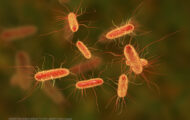A Campylobacter outbreak linked to raw milk has sickened at least 22 people in Alaska and hospitalized two of them including one child, state health officials told Food Poisoning Bulletin today. Both people who were hospitalized have been released.
 Twenty one of the 22 case patients drank the milk before becoming ill, said Dr. Brian Yablon, a medical epidemiologist with Alaska’s Division of Public Health. “There’s no question that it’s the source of the outbreak.”
Twenty one of the 22 case patients drank the milk before becoming ill, said Dr. Brian Yablon, a medical epidemiologist with Alaska’s Division of Public Health. “There’s no question that it’s the source of the outbreak.”
The milk was produced on a farm on the Kenai Peninsula, located on the southern coast of Alaska, and distributed through a cow-share program. In Alaska, the sale of raw milk for human consumption is not permitted unless the milk is consumed by the cow’s owner. Members of cow or goat shares are considered owners of the animals tended by a farmer.
Like most dairy farms in Alaska, the farm in question was small one with a total of eight cows, said Dr. Robert Gerlach, Alaska’s State Veterinarian. The farm is tidy with fairly modern equipment, he said. “But raw milk is a risky material no matter how good your operations are, there’s still a risk even under the best conditions. It’s just a risky product.”
Gerlach said his office has been working together with the Alaska Department of Health and Human Services Division of Public Health on the investigation into the outbreak. They have contacted members of the cow-share and collected samples from the farm. Because Campylobacter is difficult to culture from milk, the team took swabs from surfaces in the milking room, the equipment and from manure.
Two of those samples have tested positive for Campylobacter, but it isn’t yet known if the strain matches the outbreak strain, said Dr. Yablon. Neither of the positive samples is from the milk, but contamination of milk can be very sporadic, he said, isolating it from stool is the more common practice.
The farmer has cooperated with the investigation, but because he is not subject to testing or enforcement actions a commercial farm would be he has continued, legally, to produce raw milk for the cow-share. This may explain why two of the 22 case patients contracted Campylobacter infections twice during the outbreak, bringing the total number of reported incidents of infection to 24.
The outbreak was announced February 15. No news cases have been reported in the last five days so the outbreak may have peaked, said Yablon. Although public health officials warn against the risk of infection from pathogens such as Listeria, E.coli, Salmonella, Brucella and Yersinia, some people drink raw milk and they have different reasons for doing so, some drink it for the perceived health benefit, others to support their local economy, he said. And they all have varying levels of understanding the risk involved. More than likely a person isn’t going to get sick form drinking raw milk, but the risk of illness is much higher, Yablon said. “It’s like a game of Russian Roulette, you could get lucky, but it’s hard to quantify how many bullets are in that gun.”




